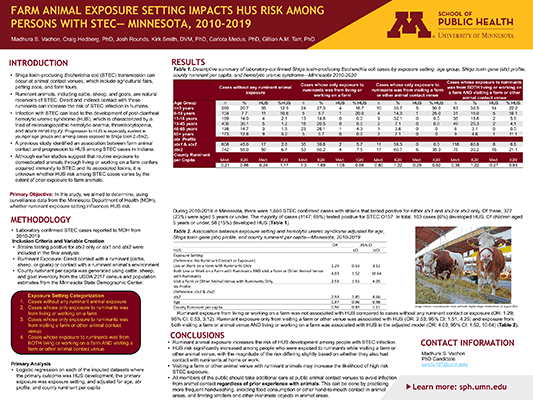Madhura Vachon
PhD, Environmental Health
Co-Authors:
Craig Hedberg, Josh Rounds, Kirk Smith, Carlota Medus, Gillian A.M. Tarr
Advisor:
Craig Hedberg
Keywords:
Shiga toxin-producing Escherichia coli; Animal contact venues
Abstract
Shiga toxin-producing Escherichia coli (STEC) transmission occurs in ruminant contact settings and can lead to post-diarrheal hemolytic uremic syndrome (HUS). We investigated whether exposure setting (ruminant exposure from living or working on a farm, from visiting a farm or animal contact venue, or both) influenced HUS development among individuals with laboratory-confirmed STEC infections using Minnesota surveillance data from 2010-2019. Logistic regression was performed to determine whether exposure setting was associated with HUS independent of age, stx2 gene detection, and county ruminant per capita. Among confirmed STEC cases, ruminant exposure only from living or working on a farm was not significantly associated with HUS compared to cases without any ruminant exposure (OR: 1.29; 95% CI: 0.53, 3.12). However, ruminant exposure only from visiting a farm or public animal contact venue was associated with HUS (OR: 2.53; 95% CI: 1.51, 4.25). Exposure from both settings was also associated with HUS (OR: 4.03; 95% CI: 1.52, 10.64). Exposure to ruminants when visiting farms or animal contact venues is an important predictor of HUS, even among people who live or work on farms with ruminants. All people, regardless of routine ruminant exposure, should take care in settings with ruminants to avoid infection with STEC.

View Poster (PDF)
